Check out what’s happening in the world of ACEOs and the artists who create them…30 Sec. Aceo artwork video
Tag Archives: Virgin of Guadalupe
Follow-up: Surfing Madonna Now at Home in Leucadia
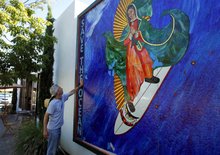 After being in storage for the last year, the famous 10×10′ stained-glass work depicting Our Lady of Guadalupe on a surfboard pulling into a barreling wave with the message “Save the Ocean” now hangs in between Cafe Ipe and surf shop Surfy Surfy on North Coast Highway in Leucadia.
After being in storage for the last year, the famous 10×10′ stained-glass work depicting Our Lady of Guadalupe on a surfboard pulling into a barreling wave with the message “Save the Ocean” now hangs in between Cafe Ipe and surf shop Surfy Surfy on North Coast Highway in Leucadia.
Being a Virgin of Guadalupe fanatic, I have been following the story (my previous article) and was so happy on Monday when I read (see the article) that she had been successfully installed at a lovely location where she can be appreciated by so many. All is right in the world, or at least in this little piece of it!

Mexican Virgin of Guadalupe Folk Art Mugs

 Mexican folk art, such as the Virgin of Guadalupe or Day of the Dead Sugar Skulls, with its bright colors, vivid imagery, and fun subject matter lends itself well to product design. Espresso mugs have recently been added to the Stuccoloco online card and gift shop. Imported and hand-printed in the USA with vivid detail, these ceramic espresso mugs are dishwasher and microwave safe. They join two sizes of coffee mugs, the 20 oz. Jumbo mug, travel mugs and your choice of styles. Add your text, a name perhaps, to give it that personalized touch. Make great gifts!
Mexican folk art, such as the Virgin of Guadalupe or Day of the Dead Sugar Skulls, with its bright colors, vivid imagery, and fun subject matter lends itself well to product design. Espresso mugs have recently been added to the Stuccoloco online card and gift shop. Imported and hand-printed in the USA with vivid detail, these ceramic espresso mugs are dishwasher and microwave safe. They join two sizes of coffee mugs, the 20 oz. Jumbo mug, travel mugs and your choice of styles. Add your text, a name perhaps, to give it that personalized touch. Make great gifts!
Other artwork, including Mermaids, Butterflies, and other fun designs are also on offer. Don’t see what you want? Contact me for special alterations or requests. Never an extra fee. milagroartmix@gmail.com
Virgin of Guadalupe Cards and gifts
Artist Trading Cards (ATCs) and Artist Cards Editions and Originals (ACEOs) by Cindy Haskins Monro (Stuccoloco)
Virgin of Guadalupe Artwork now on affordable cards
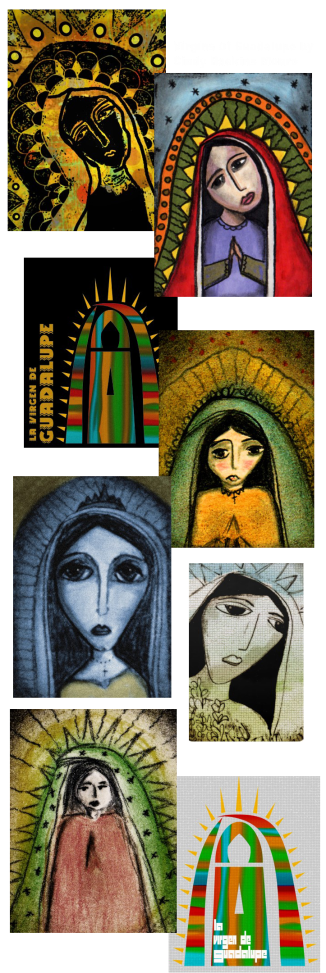 The Mexican cultural and religious icon, the Virgin of Guadalupe, has long been a favorite subject for my artwork. I am happy to offer some of my favorites on affordable greeting cards and postcards at my print-on-demand shop, Stuccoloco.
The Mexican cultural and religious icon, the Virgin of Guadalupe, has long been a favorite subject for my artwork. I am happy to offer some of my favorites on affordable greeting cards and postcards at my print-on-demand shop, Stuccoloco.
I add new images regularly, and also offer Virgin of Guadalupe artwork on other products.
Thank you for looking!
The Day of the Dead and Halloween in the Southwest-Diverse Traditions Share the Spotlight
At first glance, the Mexican custom of El Día de los Muertos (the Day of the Dead) may sound much like the U.S. custom of Halloween. After all, the celebration traditionally starts at midnight the night of Oct. 31, and the festivities are abundant in images related to death.
But the customs have different origins, and their attitudes toward death are different: In the typical Halloween festivities, death is something to be feared. But in el día de los muertos, death — or at least the memories of those who have died — is something to be celebrated.
Here in the southwest United States both are observed with exuberance and joy on and around October 31st. For those unfamiliar with El Dia de los Muertos (the Day of the Dead) I include the following history and common practices.
Plans for the day are made throughout the year, including gathering the goods to be offered to the dead. During the three-day period, families usually clean and decorate graves; most visit the cemeteries where their loved ones are buried and decorate their graves with ofrendas (“offerings”), which often include orange mexican marigolds (Tagetes erecta) called cempasúchitl (originally named cempoalxochitl, Nahuatl for “twenty flowers”).
In modern Mexico, this name is sometimes replaced with the term Flor de Muerto(“Flower of the Dead”). These flowers are thought to attract souls of the dead to the offerings.
Toys are brought for dead children (los angelitos, or “the little angels”), and bottles of tequila, mezcal or pulque or jars of atole for adults. Families will also offer trinkets or the deceased’s favorite candies on the grave. Ofrendas are also put in homes, usually with foods such as candied pumpkin, pan de muerto (“bread of the dead”), and sugar skulls and beverages such as atole. The ofrendas are left out in the homes as a welcoming gesture for the deceased. Some people believe the spirits of the dead eat the “spiritual essence” of the ofrendas food, so even though the celebrators eat the food after the festivities, they believe it lacks nutritional value. Pillows and blankets are left out so that the deceased can rest after their long journey. In some parts of Mexico, such as the towns of Mixquic, Pátzcuaro and Janitzio, people spend all night beside the graves of their relatives. In many places, people have picnics at the grave site as well.
Some families build altars or small shrines in their homes; these usually have the Christian cross, statues or pictures of the Blessed Virgin Mary, pictures of deceased relatives and other persons, scores of candles and an ofrenda. Traditionally, families spend some time around the altar, praying and telling anecdotes about the deceased. In some locations, celebrants wear shells on their clothing, so that when they dance, the noise will wake up the dead; some will also dress up as the deceased.
Public schools at all levels build altars with ofrendas, usually omitting the religious symbols. Government offices usually have at least a small altar, as this holiday is seen as important to the Mexican heritage.
 Those with a distinctive talent for writing sometimes create short poems, called calaveras (“skulls”), mocking epitaphs of friends, describing interesting habits and attitudes or funny anecdotes. This custom originated in the 18th or 19th century, after a newspaper published a poem narrating a dream of a cemetery in the future, “and all of us were dead”, proceeding to “read” the tombstones. Newspapers dedicate calaveras to public figures, with cartoons of skeletons in the style of the famous calaveras of José Guadalupe Posada, a Mexican illustrator. Theatrical presentations of Don Juan Tenorioby José Zorrilla (1817–1893) are also traditional on this day.
Those with a distinctive talent for writing sometimes create short poems, called calaveras (“skulls”), mocking epitaphs of friends, describing interesting habits and attitudes or funny anecdotes. This custom originated in the 18th or 19th century, after a newspaper published a poem narrating a dream of a cemetery in the future, “and all of us were dead”, proceeding to “read” the tombstones. Newspapers dedicate calaveras to public figures, with cartoons of skeletons in the style of the famous calaveras of José Guadalupe Posada, a Mexican illustrator. Theatrical presentations of Don Juan Tenorioby José Zorrilla (1817–1893) are also traditional on this day.
A common symbol of the holiday is the skull (colloquially called calavera), which celebrants represent in masks, called calacas (colloquial term for “skeleton”), and foods such as sugar or chocolate skulls, which are inscribed with the name of the recipient on the forehead. Sugar skulls are gifts that can be given to both the living and the dead. Other holiday foods include pan de muerto, a sweet egg bread made in various shapes from plain rounds to skulls and rabbits, often decorated with white frosting to look like twisted bones.
José Guadalupe Posada created a famous print of a figure that he called La Calavera de la Catrina (“calavera of the female dandy”) as a parody of a Mexican upper-class female. Posada’s striking image of a costumed female with a skeleton face has become associated with the Day of the Dead, and Catrina figures often are a prominent part of modern Day of the Dead observances.
The traditions and activities that take place in celebration of the Day of the Dead are not universal and often vary from town to town. For example, in the town of Pátzcuaro on the Lago de Pátzcuaro in Michoacán, the tradition is very different if the deceased is a child rather than an adult. On November 1 of the year after a child’s death, the godparents set a table in the parents’ home with sweets, fruits, pan de muerto, a cross, a rosary (used to ask the Virgin Mary to pray for them) and candles. This is meant to celebrate the child’s life, in respect and appreciation for the parents. There is also dancing with colorful costumes, often with skull-shaped masks and devil masks in the plaza or garden of the town. At midnight on November 2, the people light candles and ride winged boats called mariposas(Spanish for “butterflies”) to Janitzio, an island in the middle of the lake where there is a cemetery, to honor and celebrate the lives of the dead there.
In contrast, the town of Ocotepec, north of Cuernavaca in the State of Morelos, opens its doors to visitors in exchange for veladoras (small wax candles) to show respect for the recently deceased. In return, the visitors receive tamales and atole. This is only done by the owners of the house where somebody in the household has died in the previous year. Many people of the surrounding areas arrive early to eat for free and enjoy the elaborate altars set up to receive the visitors from Mictlán.
 In some parts of the country (especially the cities, where in recent years there are displaced other customs), children in costumes roam the streets, knocking on people’s doors for a calaverita, a small gift of candies or money; they also ask passersby for it. This custom is similar to that of Halloween’s trick-or-treating and is relatively recent.
In some parts of the country (especially the cities, where in recent years there are displaced other customs), children in costumes roam the streets, knocking on people’s doors for a calaverita, a small gift of candies or money; they also ask passersby for it. This custom is similar to that of Halloween’s trick-or-treating and is relatively recent.
Some people believe that possessing Day of the Dead items can bring good luck. Many people get tattoos or have dolls of the dead to carry with them. They also clean their houses and prepare the favorite dishes of their deceased loved ones to place upon their altar or ofrenda.
El día de los muertos, which continues until Nov. 2, has become one of the biggest holidays in Mexico, and celebrations are becoming more common in areas of the United States with a large Hispanic population. Its origins are distinctly Mexican: During the time of the Aztecs, a monthlong summer celebration was overseen by the goddess Mictecacihuatl, the Lady of the Dead. After the Aztecs were conquered by Spain and Catholicism became the dominant religion, the customs became intertwined with the Christian commemoration of All Saints’ Day on Nov. 1.
Specifics of the celebration vary with region, but one of the most common customs is the making of elaborate altars to welcome departed spirits home. Vigils are held, and families often go to cemeteries to fix up the graves of their departed relatives. Festivities also frequently include traditional foods such as pan de muerto(bread of the dead), which can conceal a miniature skeleton.
Stuccoloco Halloween Art and GiftsStuccoloco Dia de los Muertos Art and GiftsStuccoloco Multi-Cultural Art and Gifts Shop 
Stuccoloco greeting cardsStuccoloco postcardsZazzle world wide marketplace photo cardsZazzle designer invitations
Zazzle Black Similar to Amazon Prime!
 Similar to Amazon Prime, Zazzle Black allows our customers to make purchases without the high shipping costs that we have all experienced. I am very excited about Zazzle Black because it neutralizes one of the main reasons shopping online is sometimes considered impractical.
Similar to Amazon Prime, Zazzle Black allows our customers to make purchases without the high shipping costs that we have all experienced. I am very excited about Zazzle Black because it neutralizes one of the main reasons shopping online is sometimes considered impractical.
Previously, Zazzle offered free economy shipping on orders over $50.oo as long as no other discount or sale code had been used. With Zazzle Black, you may take advantage of sales and discounts and still receive free shipping, and the shipping method is standard rather than the slower, untrackable economy class shipping.
A great deal for $9.95 per year, with a 30 day free trial thrown in! At that price, Zazzle Black has paid for itself on your second order. An upgrade to 2nd day shipping is available also for $39.95.
Check it out-this is a wonderful offering from our online partner, Zazzle, Inc.
Free Shipping.
- No minimums.
- Ships anywhere in the US.
The Zazzle Black program is an exclusive membership program that gives you FREE standard shipping or 2-day shipping to any location in the continental U.S., Alaska, and Hawaii, and exclusive discounts on Zazzle products.
|
TWO AMAZING PROGRAMS |
|
|
| Zazzle BlackStandard |
|
FREE Trial |
| Zazzle Black2-Day |
|
$39.95* |
Start Now with a Free Trial
Try Zazzle Black for free! Sign up for a 30-day free trial and enjoy FREE standard shipping on any order you place for a 30-day period. Sign up now and your trial starts instantly!
Want it faster? Get more from Zazzle Black 2-Day!
Get MORE Zazzle Black with FREE 2-day shipping! For just $39.95 annually, enjoy FREE 2-day shipping on all qualifying orders for products except KEDS shoes and the same privileges of Zazzle Black Standard. Sign up today!
FAQ
What types of shipping do I get with Zazzle Black?
For $9.95 annually, you get free standard shipping with tracking to any location in the continental U.S., Alaska, and Hawaii. For $39.95 annually, you get free 2-day shipping with tracking to any qualifying address in the U.S. (excluding its territories) and free standard shipping to any address in the U.S (excluding its territories).
How do I get free 2-day shipping?
Free 2-day shipping is available for just $39.95 annually with Zazzle Black 2-Day. Sign up here!
If I sign up for Zazzle Black 2-Day after Zazzle Black Standard do I get a discount?
Absolutely! If you’re already a Zazzle Black Standard member, you will receive a $9.95 discount on your first year of Zazzle Black 2-Day at any time prior to expiration of your membership. Sign up now for Zazzle Black 2-Day!
What addresses are eligible for Zazzle Black shipping?
Free standard shipping can be used for addresses in the continental U.S., PO boxes, APO/FPO addresses with U.S. zip codes, Alaska, and Hawaii. Free 2-day shipping can be used for addresses in the continental U.S., Alaska, and Hawaii. Free 2-day shipping does not ship to PO boxes or APO/FPO addresses and does not apply to orders for Keds shoes.
Starting your free trial is easy! Go here to learn how to enroll into the Zazzle Black program in just a few minutes. You’ll need your credit card, but you will not be charged for your free trial. When your free trial comes to end, we’ll enroll you in your first year of Zazzle Black standard membership for $9.95 annually. If you do not wish to enroll in the Zazzle Black program after your free trial, you can let us know by opting out on your Zazzle Black program management page at any time prior to expiration of the free trial, and you will not be charged.
What Zazzle products qualify for the Zazzle Black program?
All products offered on the website by Zazzle today qualify for free standard shipping. Keds Shoes do not qualify for free 2-day shipping.
How does the automatic renewal work?
Once you’ve enrolled in Zazzle Black, your account is setup to automatically renew at the end of each year by charging the credit card you provided. To see your renewal date, change your credit card on file, or disable automatic renewal visit the Zazzle Black program management in your account.
Can I share my Zazzle Black benefits?
At this time, you cannot share your Zazzle Black program benefits across multiple accounts.
What happens if I get charged for shipping?
If you believe that you were erroneously charged for shipping, please contact Zazzle Customer Support with your shipping and order information, and we’ll work quickly to resolve the issue!
Can I turn off automatic renewal?
Absolutely. Visit the Zazzle Black program management page in your account and click the “do not renew” check box. This will allow you to have Zazzle Black for the remainder of your annual membership but will not charge you for the next renewal cycle.
To cancel your Zazzle Black program membership, visit the Zazzle Black program management in your account and click the “do not renew” button. Your membership will no longer auto-renew, but you will continue to enjoy benefits through the term of your membership. We do not offer refunds for cancelling the Zazzle Black program prior to the end of the current term.
Does Zazzle Black work on international shipments?
No. At this time the Zazzle Black program benefits do not include international shipments.
I’m a reseller; can I use Zazzle Black to ship my packages?
The Zazzle Black program is intended to be a personal shipping program. The Zazzle Black program may not be used to distribute products for resale or to be used to ship products to your customers or potential customers. Zazzle reserves the right to terminate membership in the Zazzle Black program for any accounts that Zazzle determines has violated this policy. In such case, Zazzle will not be required to refund any portion of the membership fee and will be entitled to recover shipping charges for orders that violated this policy.
Can I enroll into the Zazzle Black program using a Zazzle Gift Certificate?
No. You may only enroll in the Zazzle Black program using a valid credit card or Paypal account.
* Terms and conditions apply. Orders for certain products and orders shipping to PO Boxes and APO/FPO addresses do not qualify for two-day shipping.
I like this deal and have signed up. I can now purchase using sale and discount codes AND get free shipping!
Zazzle has featured my shop, ‘STUCCOLOCO’ on the front page!
Save the Surfing Madonna of Encinitas!
 I just came across a Facebook page dedicated to saving this beautiful mosaic accompanied by the following information. If you would like to help save her, I provide a link to the petition to sign. I just came across a Facebook page dedicated to saving this beautiful mosaic accompanied by the following information. If you would like to help save her, I provide a link to the petition to sign.“This 10 foot by 10 foot brightly colored mosaic of the Virgin of Guadalupe riding a surfboard and catching a huge wave seemed to mysteriously appear in Encinitas, CA. Along the side, it says, “Save the Ocean.”Now the mayor and others may want to remove it because it wasn’t authorized and is deemed graffiti.In a May 17 NPR story, Encinitas Mayor James Bond says the piece “qualifies for graffiti.” Bond says that because the artist ignored the city’s rules, allowing the piece to stay would set a bad precedent.”
Surfing Madonna-Follow Up
Surfing Madonna to come down;artist to payBy Jonathan HornOriginally published 12:43 p.m., June 21, 2011, updated 5:55 p.m., June 21, 2011
People gather to see the Madonna surfing mosaic on the railroad bridge support at Encinitas Boulevard.Local resident Brennan Savage photographs his son, Liam, 9. — Charlie NeumanENCINITAS — The Surfing Madonna mosaic will be removed from the train bridge on Encinitas Boulevard “as soon as possible,” and the artist will pay for it, and more. That’s the crux of a settlement announced Tuesday between Surfing Madonna artist Mark Patterson and the city of Encinitas over what to do with the unauthorized but beloved stained-glass mosaic of Our Lady of Guadalupe on a surfboard. Under the agreement, Patterson will pay for the piece to be taken down. He will also reimburse the city the $2,125 it paid for Los Angeles-based Sculpture Conservation Studio to study removal techniques, and pay a $500 administrative fine to Encinitas. In a report also released Tuesday, the studio estimates it would cost $5,750 to remove the mosaic intact. The agreement also says Patterson must refrain from placing future art on city property without authorization. And he will pay for any safety inspection or repairs done on the bridge because of the mosaic’s installation. Patterson, however, retains ownership of the piece, and will focus on finding a new spot for it in Encinitas, whether on private property or public land. “I intended it to be a gift for the community, and I’m not going to sell it off anywhere,” Patterson said Tuesday. A removal date and time was not publicly released. Patterson said it might take six months before the Surfing Madonna finds a new location. Anton Gerschler, Patterson’s attorney, said he has received offers from more than a dozen private locations to display the mosaic. Patterson and another man installed the 10-foot-by-10-foot piece under the bridge on Encinitas Boulevard just east of Highway 101 on April 22, which was Earth Day and Good Friday. It reads “Save the Ocean” down the left side. The mosaic did not go through the city’s customary public-art approval process. The identity of the artist was a mystery in Encinitas for nearly two months. Hundreds of people flocked to see the work. Supporters created Facebook and Twitter pages devoted to saving the piece. Despite its popularity, Encinitas officials quickly labeled the mosaic as defacement. Councilman Jerome Stocks has said leaving the piece on public land invites lawsuits because it is a religious symbol, and it creates a legal defense for graffiti. The City Council voted unanimously last month that the mosaic must go. On Tuesday, several people came to Encinitas to view the mosaic one last time before it comes down. Someone also left a candle holder at the base of the mosaic, depicting Pope John Paul II. It was filled with yellow tulips. “This took time, effort, and money, and there was a drive behind it,” said Megan O’Rourke of Pacific Beach. “Who is this hurting?” “I think it’s gorgeous,” said Christine Ensign, of University Heights. “I don’t think it’s graffiti; it’s art. It looks like somebody was paid to do this.” But Patterson did the work for free. An Encinitas resident since 1983, Patterson said he quit his job at a software company in late 2010 so he could devote his time to creating the Surfing Madonna, a vision he first had in 2005. He said he ignored that vision until it returned to him powerfully in 2009. He then took a prestigious two-week class in Italy in September 2010 on mosaic making. He quit his job a month later. The mosaic took him nine months to complete. Patterson is still living off his savings. He came forward June 8 after inspectors from Sculpture Conservation Studio concluded a day earlier that the piece would be almost impossible to remove without damage. Gerschler, Patterson’s lawyer, contacted the city to say Patterson was the artist and knew how to take down the piece intact. Two weeks of negotiations since led to Tuesday’s agreement. Patterson has said he was unaware of the laws regarding public-art approval. Patterson, who is not Catholic, said the mosaic’s message is not religious; it’s to save the ocean. While he acknowledges his savings will take a hit from the fines, his supporters might help him pay them. Dody Crawford, who heads the Downtown Encinitas MainStreet Association, said a fundraising group called “Our Lady of Encinitas” is ready to fundraise if Patterson asks. Patterson said he appreciates the generosity, but he hasn’t “crossed that bridge yet.” June 2012 Follow up article-Madonna has a home |
Contributing Artist: William Ahrendt
Contributing Artist: William Ahrendt
See his paintings depicting the old west at our non-profit on-line Tubac Presidio Park Gift Shop. All proceeds go directly to preserving our lovely park!


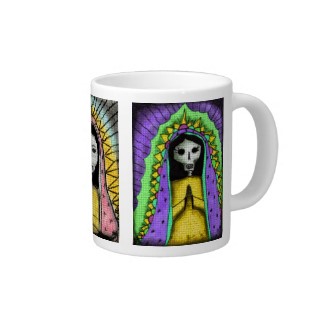
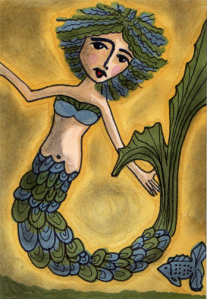


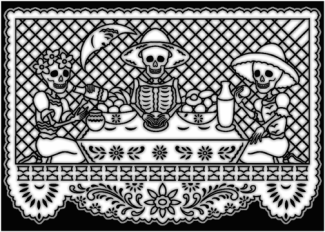








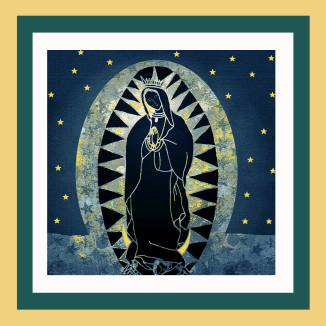
You must be logged in to post a comment.